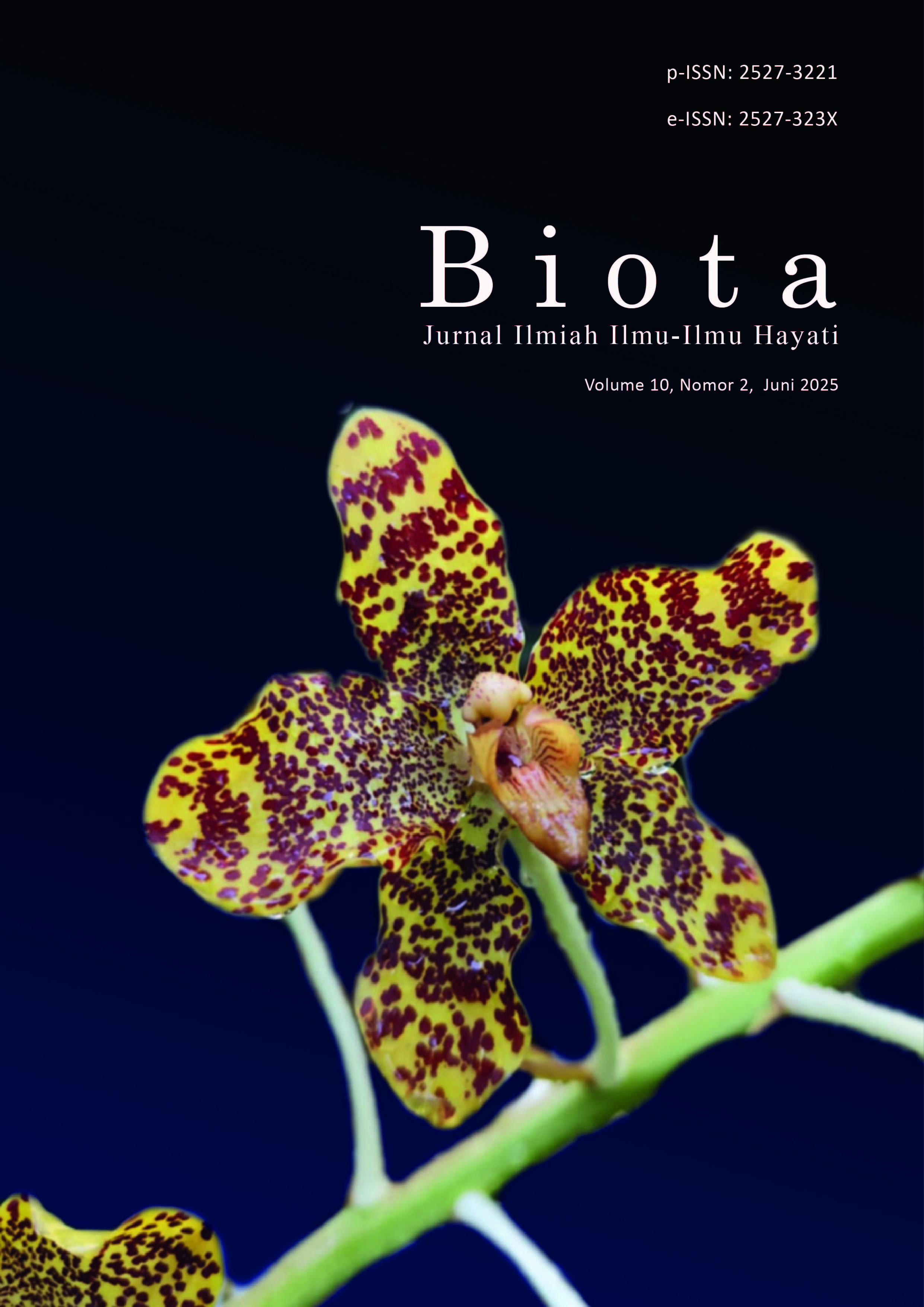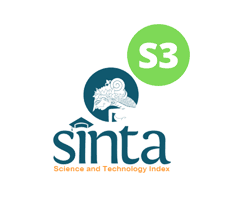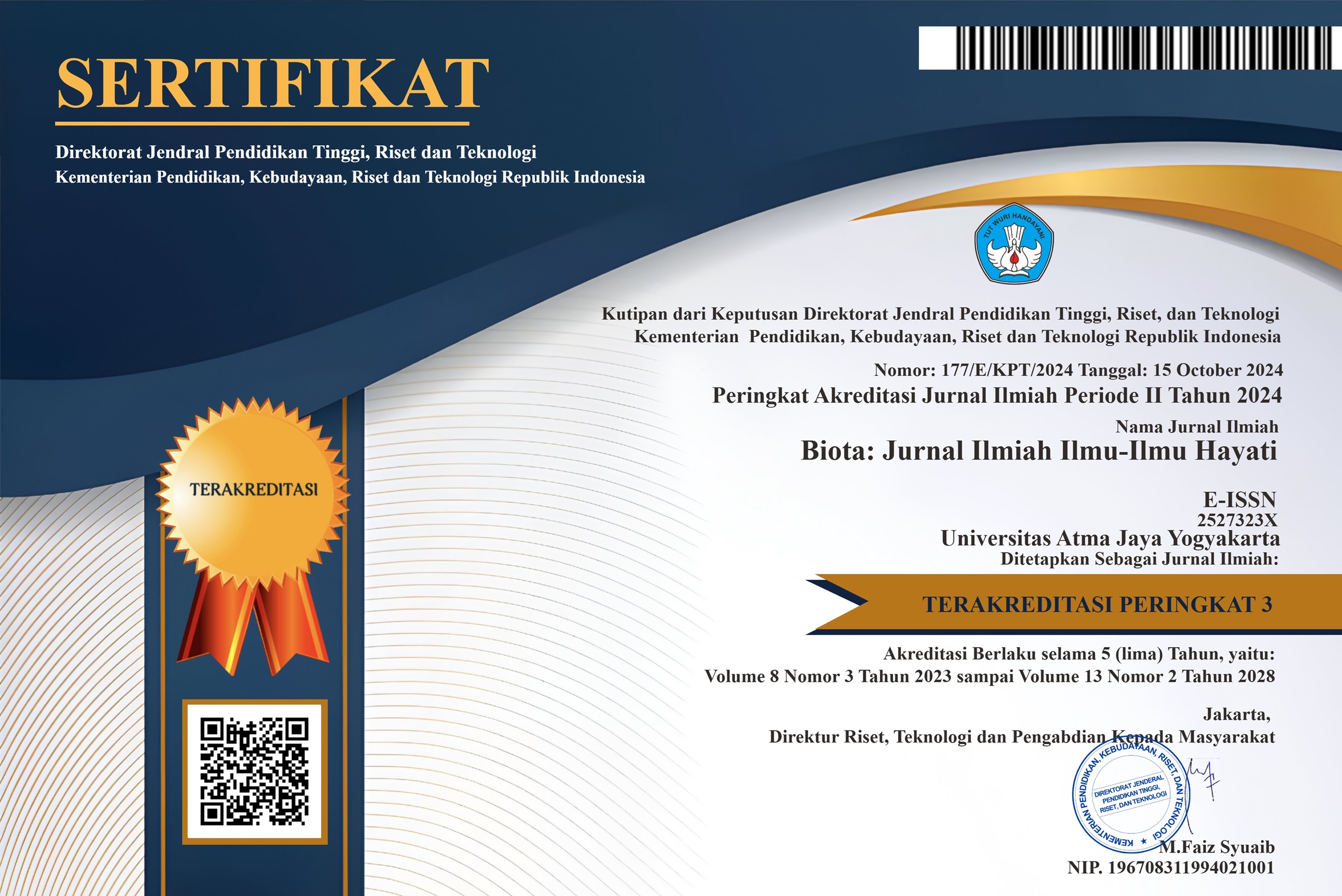Vigor Enhancement of Tomato (Solanum lycopersicum) using Spirulina platensis as Seed Priming Agent
DOI:
https://doi.org/10.24002/biota.v10i2.10220Keywords:
Biostimulant, seed priming, Spirulina platensis, Sugar Mill Effluent, tomatoAbstract
Seed priming is a technique to enhance seed germination. Biopriming, a specific method, involves soaking seeds in biological agents such as Spirulina platensis, a microalga that can thrive in agricultural waste including Sugar Mill Effluent (SME). Spirulina sp. contains various beneficial growth hormones, making it a potential seed priming agent. This research aimed to determine the effectiveness of tomato seed priming using Spirulina platensis grown on SME. The research was conducted from May to August 2024 at the Seed Technology Laboratory, Politeknik Negeri Jember. The research method used a factorial Completely Randomized Design which included Spirulina platensis biomass concentrations (0, 30, 45, and 60%) and soaking durations (1, 2, and 3 hours). Analysis of variance using the Bonferroni post-hoc test at a 5% level using GraphPad Prism version 5.01. The results showed that seed priming with S. platensis positively influenced several physiological parameters, including mean germination time, vigor index, seed growth rate, and shoot length. These findings demonstrated that SME-grown S. platensis cells capable of improving the physiological quality of tomato seeds, making it one of the environmentally friendly seed invigorating techniques.
References
Acharya, P., Jayaprakasha, G. K., Crosby, K. M., Jifon, J. L., & Patil, B. S. (2020). Nanoparticle mediated seed priming improves germination, growth, yield, and quality of watermelons (Citrullus lanatus) at multi-locations in Texas. Scientific Reports 10(1): 5037.
Akgul, F. (2019). Effect of Spirulina platensis (gomont) geitler extract on seed germination of wheat and barley. Alınteri Zirai Bilimler Dergisi 34(2): 148–153.
Alfadhly, N. K. Z., Alhelfi, N., Altemimi, A. B., Verma, D. K., & Cacciola, F. (2022). Tendencies affecting the growth and cultivation of genus Spirulina: an investigative review on current trends. Plants 11(22): 1–21. Https://Doi.Org/10.3390/Plants11223063
Alling, T., Funk, C., & Gentili, F. G. (2023). Nordic microalgae produce biostimulant for the germination of tomato and barley seeds. Scientific Reports 13(1): 1–9.
Andayani, R. D., & Rosanti, A. D. (2023). Seed priming application to increase sorghum vigor and viability of Sorghum bicolor. Agrovigor: Jurnal Agroekoteknologi 16(1): 35–39.
Andianingsih, N., Rosmala, A., & Mubarok, S. (2021). Pengaruh pemberian hormon auksin dan giberelin terhadap pertumbuhan tomat (Solanum lycopersicum L.) Var. Aichi First di dataran medium. Agroscript 3(1); 48–56.
Deshmane, A. B., Darandale, V. S., Nimbalkar, D. S., Nikam, T. D., & Ghole, V. S. (2016). Sugar mill effluent treatment using spirulina for recycling of water, saving energy and producing protein. International Journal Of Environmental Science And Technology 13(2): 749–754.
Deshmane, A., Nimbalkar, D., Nikam, T. D., & Ghole, V. S. (2016). Exploring alternative treatment method for sugar industry effluent using ‘Spirulina platensis.’ sugar tech, 18(1), 105–108.
Deshmukh, A. J., Jaiman, R. S., Bambharolia, R. P., & Patil, V. A. (2020). Seed biopriming– a review. International Journal Of Economic Plants, 7(1), 038–043.
Do, T. C., Tran, T., Le, G., & Nguyen, T. (2020). Characterization of endogenous auxins and gibberellins produced by Chlorella sorokiniana TH01 under phototrophic and mixtrophic cultivation modes toward applications in microalgal biorefinery and crop research. Journal of Chemistry 2020(4):1-11.
Farooq, M., Usman, M., Nadeem, F., Rehman, H. Ur, Wahid, A., Basra, S. M. A., & Siddique, K. H. M. (2019). Seed priming in field crops: potential benefits, adoption and challenges. Crop And Pasture Science 70(9): 731–771.
Ferreira, A., Bastos, C. R. V., Marques-Dos-Santos, C., Acién-Fernandez, F. G., & Gouveia, L. (2023). Algaeculture for agriculture: from past to future. Frontiers In Agronomy 5:1–26.
Fito, J., Tefera, N., & Van Hulle, S. W. H. (2019). Sugarcane biorefineries wastewater: bioremediation technologies for environmental sustainability. Chemical And Biological Technologies In Agriculture 6(1): 1–13.
García-Locascio, E., Valenzuela, E. I., & Cervantes-Avilés, P. (2024). Impact of seed priming with selenium nanoparticles on germination and seedlings growth of tomato. Scientific Reports 14(1): 1–12.
Geshnizjani, N., Ghaderi-Far, F., Willems, L.A.J. et al. (2018). Characterization of and genetic variation for tomato seed thermo-inhibition and thermo-dormancy. BMC Plant Biol 18:229.
Gunadi, H., & Djunaidy, M. (2019). Aplikasi teknologi drip irrigation dan seed priming pada pertanaman kedelai saat musim kemarau di Desa Toddolimae Dan Toddopulia. Jurnal Panrita Abdi 3(1): 70–79.
Hacisalihoglu, G., Kantanka, S., Miller, N., Gustin, J. L., & Settles, A. M. (2018). Modulation of early maize seedling performance via priming under sub-optimal temperatures. Plos One, 13(11): E0206861.
Harsono, N. A., Bayfurqon, F. M., & Azizah, E. (2021). Pengaruh periode simpan dan konsentrasi ekstrak bawah merah (Allium cepa L.) terhadap viabilitas dan vigor benih timun apel (Cucumis sp.). Jurnal Ilmiah Wahana Pendidikan, 7(8), 350-362
Indonesian Central Bureau of Statistics. (2024). Produksi Tanaman Sayuran dan Buah-Buahan Semusim Menurut Provinsi dan Jenis Tanaman. https://www.bps.go.id/id/statistics-table/3/ZUhFd1JtZzJWVVpqWTJsV05XTllhVmhRSzFoNFFUMDkjMw==/produksi-tanaman-sayuran-dan-buah-buahan-semusim-menurut-provinsi-dan-jenis-tanaman----2022.html?year=2024 : Diakses pada 1 Mei 2025
ISTA. 2020. International Rules For Seed Testing. International Seed Testing Association.
Jisha, K. C., Vijayakumari, K., & Puthur, J. T. (2013). Seed priming for abiotic stress tolerance: An overview. Acta Physiologiae Plantarum 35(5), 1381–1396.
Junaidi & Ahmad, F. (2021). Pengaruh Suhu Perendaman Terhadap Pertumbuhan Vigor Biji Kopi Laampung (Coffeacanephora). Jurnal Inovasi Petanian, 2(7), 52–61.
Komalasari, O., & Arief, R. (2020). Effect of soaking duration in hydropriming on seed vigor of sorghum (Sorghum bicolor L. Moench). IOP Conference Series: Earth and Environmental Science 484(1): 012121.
Kumar, N., Chaudhary, A., Ahlawat, O. P., Naorem, A., Upadhyay, G., Chhokar, R. S., Gill, S. C., Khippal, A., Tripathi, S. C., & Singh, G. P. (2023). Crop residue management challenges, opportunities and way forward for sustainable food-energy security in India: A Review. Soil And Tillage Research 228:105641.
Matthews, S., & Hosseini, K.M. (2006). Mean germination time as an indicator of emergence performance in soil of seed lots of maize (Zea mays). Seed Science And Technology 34(2): 339–347.
Mora, Y. F., Rafli, M., Ismadi, I., Faisal, F., & Nilahayati, N. (2022). Uji perkecambahan benih jagung manis (Zea mays Saccharata Sturt) pada berbagai media kertas menggunakan alat perkecambahan benih F&F Manual Germinator. Jurnal Ilmiah Mahasiswa Agroekoteknologi 1(3): 58.
Mukherjee, D. (2018). Effect Of Different Seed Priming Treatments On Germination And Seedling Establishment Of Two Threatened Endangered Medicinal Plants Of Darjeeling Himalaya. In A. Rakshit & H. B. Singh (Eds.), Advances In Seed Priming (241–262). Springer Singapore.
Nguyen, Q. T., & Sundareswaran, S. (2018). Effects of seed priming with Spirulina platensis extract on physiological and biochemical seed quality parameters in blackgram (Vigna mungo L.) CV. CO6. International Journal of Agriculture Sciences 10(24): 7648–7651.
Nurwiati, W., & Budiman, C. (2023). Uji cepat vigor benih tomat (Solanum lycopersicum L.) dengan metode radicle emergence. Buletin Agrohorti: 11(2), 260–265.
Paparella, S., Araújo, S. S., Rossi, G., Wijayasinghe, M., Carbonera, D., & Balestrazzi, A. (2015). Seed priming: State of the art and new perspectives. Plant Cell Reports 34(8): 1281–1293.
Prasetya, W., Yulianah, I., Lestari, S., Jurusan, P., Pertanian, B., & Pertanian, F. (2017). Pengaruh teknik ekstraksi dan varietas terhadap viabilitas benih tomat (Lycopersicum esculentum L.). Jurnal Produksi Tanaman 5(2): 257–264.
Ridlo, A., Sedjati, S., & Supriyantini, E. (2016). Aktivitas anti oksidan fikosianin dari Spirulina sp. menggunakan metode transfer elektron dengan DPPH (1,1-Difenil-2-Pikrilhidrazil). Jurnal Kelautan Tropis, 18(2): 58–63.
Shedeed, Z. A., Gheda, S., Elsanadily, S., Alharbi, K., & Osman, M. E. H. (2022). Spirulina platensis biofertilization for enhancing growth, photosynthetic capacity and yield of lupinus luteus. Agriculture (Switzerland) 12(6): 1–15.
Shrestha, A., Pradhan, S., Shrestha, J., & Subedi, M. (2019). Role of seed priming in improving seed germination and seedling growth Of maize (Zea mays L.) under rain fed condition. Journal Of Agriculture And Natural Resources 2(1): 265–273.
Tabassum, T., Farooq, M., Ahmad, R., Zohaib, A., Wahid, A., & Shahid, M. (2018). Terminal drought and seed priming improves drought tolerance in wheat. Physiology And Molecular Biology Of Plants 24(5): 845–856.
Thinh, N. Q. (2021). Influences of seed priming with Spirulina Platensis extract on seed quality properties in black gram (Vigna mungo L.). Vietnam Journal Of Science, Technology And Engineering 63(1): 36–41.
UTEX. (2019). Iron Stock Solution Boron Stock Solution. Utex.Org, 30–32. --> Sitasi seperti apa ini?
Wibowo, N. I. (2020). Efektifitas daya berkecambah benih padi pandanwangi dengan menggunakan metode kertas. Agroscience (Agsci), 10(1): 38.
Xue, X., Du, S., Jiao, F., Xi, M., Wang, A., Xu, H., Jiao, Q., Zhang, X., Jiang, H., Chen, J., & Wang, M. (2021). The regulatory network behind maize seed germination: effects of temperature, water, phytohormones, and nutrients. Crop Journal 9(4): 718–724.
Downloads
Published
How to Cite
Issue
Section
License
Copyright (c) 2025 Indah Wahyu Pratiwi, Fitri Ayu Rahmawati, Kariena Samtani, Nuning Atuilah, Reza Aris Hidayatullah, Nur Aini Alfiah, Elly Daru Ika Wilujeng, Devina Cinantya Anindita, Moh Hasbi Ash Shidiqi, Moch. Rosyadi Adnan

This work is licensed under a Creative Commons Attribution-NonCommercial 4.0 International License.
Authors who publish with Biota : Jurnal Ilmiah Ilmu-Ilmu Hayati agree to the following terms:
- Authors retain copyright and grant the Biota : Jurnal Ilmiah Ilmu-Ilmu Hayati right of first publication. Licensed under a Creative Commons Attribution-NonCommercial 4.0 International License that allows others to share the work with an acknowledgment of the work's authorship and initial publication in this journal.
- Authors are able to enter into separate, additional contractual arrangements for the non-exclusive distribution of the journal's published version of the work (e.g., post it to an institutional repository or publish it in a book), with an acknowledgment of its initial publication in Biota : Jurnal Ilmiah Ilmu-Ilmu Hayati, and as long as Author is not used for commercial purposes.













